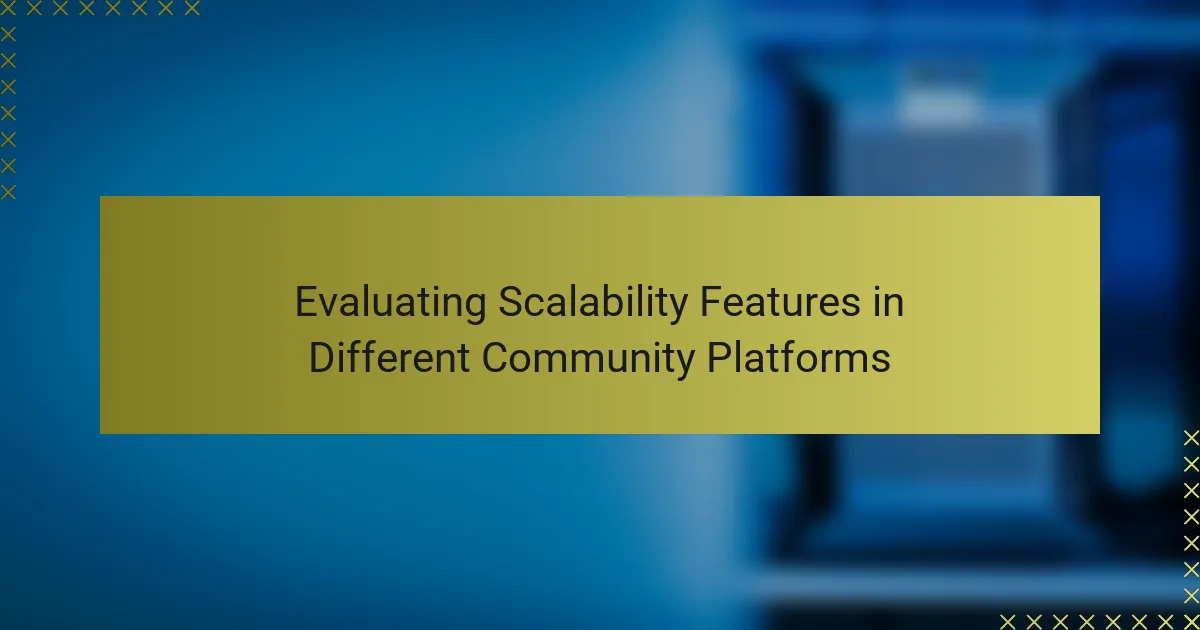Understanding the costs associated with scalability in community projects is essential for ensuring their growth and sustainability. These costs can significantly affect a project’s success and require careful planning and resource management. By implementing strategic budget planning and identifying diverse funding sources, community projects can navigate the challenges of scaling effectively.

What are the costs of scalability in community projects?
The costs of scalability in community projects encompass various financial and resource-related factors that can impact the project’s growth and sustainability. Understanding these costs is crucial for effective planning and execution, as they can significantly influence the project’s overall success.
Operational expenses
Operational expenses refer to the ongoing costs required to maintain and grow a community project. These can include staffing, utilities, and administrative costs, which can increase as the project scales. For instance, a small community initiative may operate on a budget of a few thousand dollars, while larger projects might require tens of thousands annually.
To manage operational expenses effectively, consider implementing a budget that accounts for both fixed and variable costs. Regularly reviewing and adjusting this budget can help identify areas for potential savings or necessary investments.
Resource allocation
Resource allocation involves distributing available resources, such as time, personnel, and finances, to various aspects of a community project. As projects scale, the demand for resources often increases, necessitating a strategic approach to ensure that critical areas receive adequate support. For example, a growing project might need to hire additional staff or invest in training for existing members.
To optimize resource allocation, prioritize tasks based on their impact on project goals. Utilize tools like project management software to track resource usage and identify any bottlenecks that may arise as the project expands.
Technology investments
Technology investments are essential for facilitating the scalability of community projects. This can include software for communication, project management, and data analysis, as well as hardware like computers and servers. The initial investment can vary widely, from a few hundred dollars for basic tools to several thousand for more advanced systems.
When considering technology investments, assess both current needs and future growth. Opt for scalable solutions that can adapt as the project evolves, and explore open-source or low-cost options to minimize upfront costs while still meeting essential requirements.

How can community projects manage scalability costs?
Community projects can manage scalability costs by implementing strategic budget planning, identifying diverse funding sources, and conducting thorough cost-benefit analyses. These practices help ensure that projects can grow sustainably without overspending or compromising their objectives.
Budget planning strategies
Effective budget planning is crucial for managing scalability costs in community projects. Start by estimating both fixed and variable costs associated with growth, such as personnel, materials, and technology. Create a flexible budget that can adapt to changes in project scope or unexpected expenses.
Consider using a tiered budgeting approach, where you outline costs for different levels of scalability. This allows you to prioritize essential expenditures while keeping an eye on potential future needs. Regularly review and adjust the budget based on actual spending and project progress.
Funding sources
Diverse funding sources can alleviate the financial burden of scaling community projects. Explore options such as grants, crowdfunding, sponsorships, and partnerships with local businesses or organizations. Each funding source may come with its own requirements and expectations, so evaluate them carefully.
For example, government grants often require detailed proposals and adherence to specific regulations, while crowdfunding can provide quick access to funds but may demand significant outreach efforts. Establishing a mix of funding sources can provide stability and reduce reliance on any single option.
Cost-benefit analysis
Conducting a cost-benefit analysis is essential for understanding the financial implications of scaling a community project. This process involves comparing the expected benefits of scaling—such as increased community engagement or expanded services—against the associated costs. Use qualitative and quantitative metrics to assess both tangible and intangible benefits.
When performing the analysis, consider potential risks and uncertainties that could impact costs or benefits. This will help you make informed decisions about whether to pursue scaling initiatives. Regularly revisit the analysis as the project evolves to ensure that it remains relevant and accurate.

What are the common challenges in scaling community projects?
Scaling community projects often involves navigating various challenges that can hinder growth and effectiveness. Key issues include limited resources, stakeholder engagement, and infrastructure limitations, each requiring careful consideration and strategic planning.
Limited resources
Limited resources are a primary challenge when scaling community projects. This can include financial constraints, insufficient manpower, or a lack of materials necessary for expansion. Organizations should assess their budget and explore funding opportunities, such as grants or partnerships, to alleviate these constraints.
To maximize limited resources, prioritize initiatives that offer the highest impact. Consider leveraging volunteer support or in-kind donations to supplement your efforts. Establishing a clear budget and tracking expenses can also help in making informed decisions about resource allocation.
Stakeholder engagement
Engaging stakeholders effectively is crucial for the success of scaling community projects. Stakeholders include community members, local businesses, and government entities, each with unique interests and expectations. Building strong relationships through regular communication and involvement can enhance commitment and support.
Consider organizing workshops or community meetings to gather input and foster collaboration. Utilize surveys to gauge stakeholder opinions and adapt your strategies accordingly. Remember, maintaining transparency about project goals and progress can significantly improve stakeholder trust and engagement.
Infrastructure limitations
Infrastructure limitations can significantly impede the scalability of community projects. This includes physical spaces, technology, and logistical frameworks needed to support larger operations. Assessing current infrastructure and identifying gaps is essential for planning effective scaling strategies.
Investing in technology solutions, such as project management software, can streamline operations and improve efficiency. Additionally, consider partnerships with local organizations that may have the necessary infrastructure to support your project. Planning for future growth by building flexible systems can help accommodate scaling needs as they arise.

What role does technology play in scalability?
Technology is crucial for scalability as it enables community projects to expand efficiently without compromising performance. By leveraging the right tools and systems, organizations can manage increased demands and enhance their operational capabilities.
Software solutions
Software solutions are essential for automating processes and managing resources effectively. Tools like customer relationship management (CRM) systems and project management software can streamline workflows, allowing teams to handle larger volumes of work with minimal additional effort.
When selecting software, consider scalability features such as cloud-based options that can grow with your needs. For instance, platforms like Salesforce or Asana offer tiered pricing and functionality that accommodate varying project sizes.
Data management tools
Data management tools help organizations handle large datasets efficiently, which is vital for scalability. Solutions like databases and data warehouses enable better data organization, retrieval, and analysis, ensuring that your community project can scale without losing valuable insights.
Look for tools that support real-time data processing and integration with other systems. Options like Amazon Redshift or Google BigQuery can manage substantial data loads and provide analytics capabilities that grow with your project.
Collaboration platforms
Collaboration platforms facilitate communication and teamwork, which are critical as projects scale. Tools like Slack or Microsoft Teams allow for seamless interaction among team members, regardless of their location, thus enhancing productivity.
Choose platforms that offer integration with other software solutions to create a cohesive ecosystem. This ensures that as your community project expands, your team can maintain effective communication and collaboration without disruption.

What are the best practices for sustainable scaling?
Sustainable scaling in community projects involves adopting strategies that promote gradual growth while maintaining resource efficiency and community engagement. Key practices include implementing incremental growth strategies and fostering active community involvement to ensure that expansion is manageable and beneficial for all stakeholders.
Incremental growth strategies
Incremental growth strategies focus on making small, manageable changes rather than large-scale shifts. This approach allows projects to adapt and learn from each phase of growth, minimizing risks associated with rapid expansion. For example, a community garden might start with a few plots and gradually increase the number as resources and interest grow.
When planning for incremental growth, consider setting clear, achievable milestones. These can include expanding the number of participants, increasing funding sources, or enhancing project offerings. Regularly review progress against these milestones to ensure that scaling efforts remain aligned with community needs and capacities.
Community involvement
Engaging the community is crucial for sustainable scaling. Involving community members in decision-making processes fosters a sense of ownership and commitment, which can lead to more robust support for the project. For instance, hosting regular meetings to gather feedback allows participants to voice their opinions and contribute to the project’s direction.
To enhance community involvement, consider creating volunteer opportunities that align with individual skills and interests. This not only helps distribute the workload but also strengthens relationships among participants. Additionally, providing training or resources can empower community members to take on leadership roles, further supporting the project’s growth.



